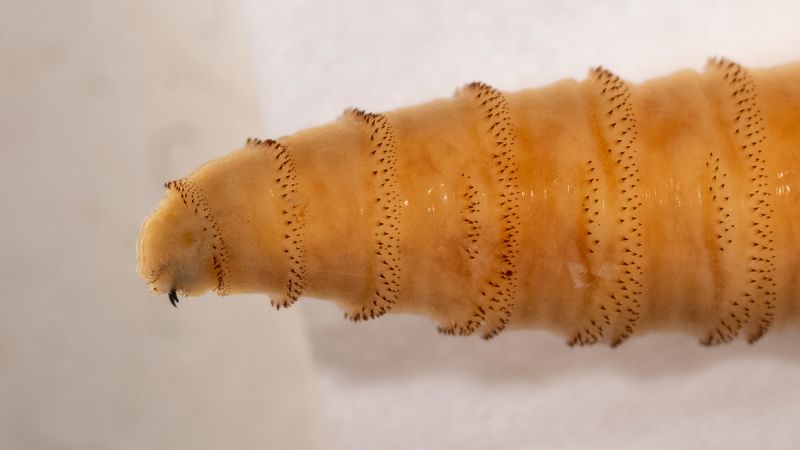The alarming notion of hundreds of millions of flies raining down from aircraft might register more as a scene from a horror movie rather than a feasible agricultural intervention. Yet, experts assert that this drastic measure could be essential for the livestock industry’s defense against the impending threat posed by New World screwworms, a flesh-eating menace currently spreading through Central America and nearing the southwestern United States border.
The New World screwworms, which are the larval stage of a specific fly species, have been wreaking havoc across Central American nations since early 2023, exhibiting infestations in countries including Panama, Costa Rica, Nicaragua, Honduras, Guatemala, Belize, and El Salvador. Such outbreaks are especially concerning, as many of these nations had not reported instances of screwworms for the past two decades. The situation escalated when the fly species reached southern Mexico in November, prompting U.S. agricultural officials to take swift action by closing various border-area trading ports for cattle, horses, and bison.
The United States has previously battled this invasive pest, having largely eradicated New World screwworm populations in the 1960s and 1970s. This was accomplished through an innovative approach that involved breeding sterilized male flies and dispersing them from planes to mate with wild females. This strategy effectively reduced the insect population as it hindered them from laying viable eggs. Unfortunately, only a single facility in Panama is currently engaged in this sterilization process, signaling a need for an expanded fly production capability in the face of the current outbreak.
To address the rising threat, the U.S. Department of Agriculture (USDA) is planning to establish a new “fly factory” near the Texas-Mexico border. However, officials have acknowledged that combating the invasion of New World screwworms is neither a quick nor inexpensive endeavor. Dr. Phillip Kaufman from Texas A&M University has highlighted that these parasitic larvae, scientifically known as Cochliomyia hominivorax, primarily inflict pain upon warm-blooded animals. Known to target livestock as well as occasionally infecting domestic pets and even humans, these flies lay hundreds of eggs on living hosts, leading to severe tissue damage and potentially fatal wounds.
According to estimates from the Panama-United States Commission for the Eradication and Prevention of Screwworm Infestation in Livestock (COPEG), over 35,000 new infestations were recorded since the outbreak started, predominantly affecting cows, which made up around 83% of reported cases. Ranchers across the region face the daunting task of regular inspections to ensure their livestock remain unaffected, as sightings of these flies could devastate their livestock and, consequently, their livelihoods.
While current remedies for infected cattle include cleaning wounds and applying antiseptic treatments, untreated infestations can lead to death within one to two weeks. Additionally, the absence of effective preventative vaccines means ranchers have to be proactive, minimizing procedures that would create wounds susceptible to infestation. With flies also likely to affect surrounding wildlife, monitoring the spread of this parasite becomes increasingly complex.
The sterilization process for producing sterile male flies involves exposing pupae to high-energy gamma rays, which effectively damage their DNA, rendering them incapable of successful reproduction. Upon release, these sterile males can mate with wild females, leading to a gradual decrease in fly populations over time. In practical terms, the USDA plans to disperse sterilized flies aerially in affected rural areas, effectively preventing urban environments from becoming impacted.
Currently, around 100 million sterilized flies are released weekly from existing COPEG facilities in Central America. However, the anticipated new fly production facility is expected to be established at Moore Air Base in Hidalgo County, Texas, with costs estimated at approximately $8.5 million. To enhance these sterilization efforts, the USDA has also committed $21 million to renovate an old fly factory in Mexico.
While the costs associated with these initiatives are considerable, many, like rancher Stephen Diebel, believe they are imperative to safeguard the multi-billion-dollar livestock industry. The financial stakes are significant, as infestations could lead to economic damage in the range of $10 billion. As Diebel asserts, improving domestic sterile fly production facilities is crucial for effectively managing the threat posed by New World screwworms.
In summary, as measures are being put in place along the Texas-Mexico border to combat the resurgence of New World screwworms, stakeholders remain cautiously optimistic. The combination of adept planning, investment in fly production facilities, and ongoing surveillance will be key to protecting livestock and maintaining economic stability in the agricultural sector.












